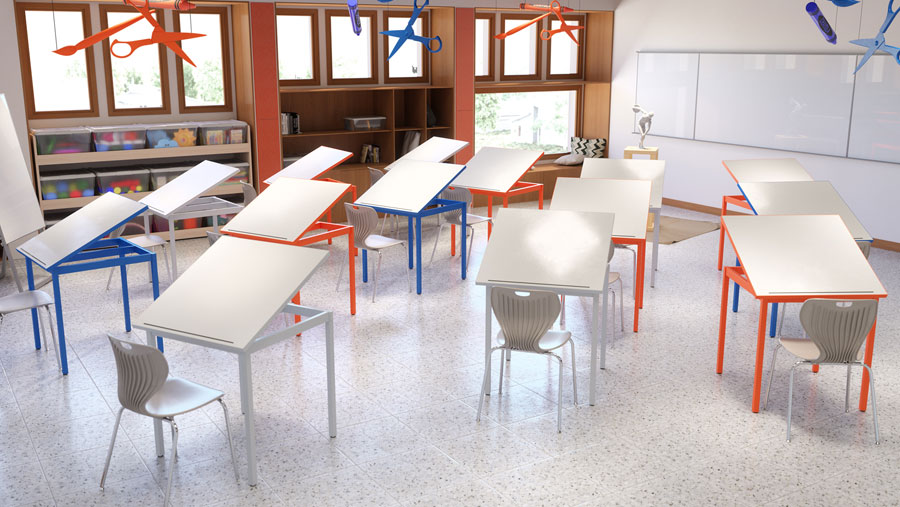
In the past century we have learned a great deal about the process of learning and yet our classrooms look much the same as they did back when we were in school.
It is only within the last few years that educators and administrators have started seriously considering a new classroom design, one that could better accommodate our growing knowledge of effective education methods. This redesigned learning space would facilitate learning experiences and support the movement toward student-directed learning. It would successfully foster the required 21st century skills, such as communication, collaboration, problem-solving, critical thinking, creativity, and leadership.
Here are 6 key elements of this new classroom design:
#1 – Flexible Furniture and Space
21st century classrooms need to accommodate a variety of learning activities, and so they must be flexible, with “zones” designated for different activities. Furniture can be arranged in nooks, each with a designated purpose, such as a learning lab or a tech zone, group seating for collaborative projects, and a “quiet space” for reading and independent study.
One goal of 21st century learning is to become more student-centric, empowering students to decide how they learn best. In a world of introverts, extroverts, collaborators, lone wolves, dreamers, and designers, we can’t merely cater to a single type of learner. An “agile” learning environment supports a variety of learning styles, while enabling teachers to accommodate different students’ needs.
The best way to get started?
Furniture, fittings and equipment (FF&E) form the ‘loose items’ of an environment that are most easily changed and therefore the most responsive to the needs of 21st Century learning’.
Try to include classroom furniture designed for easy maneuverability and reconfiguration, portable partitions, (white board or acoustic are also useful). Plan for a comfy reading zone, a teacher’s desk that can also double as a “meeting room” for student-teacher conferences and one on one instruction.
#2 – Collaborative and Independent Learning
Open, flexible spaces allow students to come together to share, collaborate, and create. Research shows that people are social learners and the latest trends in 21st century learning advocate problem-based learning, cooperative learning, and reciprocal (peer to peer) teaching. Assignments and hands-on projects that require team collaboration nurture these trends.
Our 21st century classroom must support these collaborative, social learning activities, as well as hands-on experimentation and discovery. Portable furniture, group seating, and open spaces for active, experiential projects help accomplish these goals.
Conversely, certain aspects of learning require quiet, independent study, including reflection and processing of information. This time and space should also be built into our curricula and our classrooms.
Another interesting idea is to add a “break out room” within the classroom, where students can rest their brains, especially if they get “stuck” on a certain problem. Experts believe that when the brain takes a break, it continues to work unconsciously at finding a solution, processing, and applying newly acquired information.
#3 – Embracing Movement
Let’s face it: children aren’t built to sit still. When students have the chance to move, both their brain and their circulation are refreshed. The exercise and change of pace help enhance concentration and reduce fidgeting and daydreaming.
21st century design accommodates students’ natural need to move, while providing the optimal flexibility. Movement-enhancing classroom elements include: workstations, sit – to – stand tables, balance stools, exercise balls, rocking chairs and bean-bags. For maximum functionality and accessibility, provide furniture to accommodate students of all heights.
#4 – Fostering Inspiration and Creativity
If we expect students to develop and use their creativity, we need to give them an environment that is conducive to inspiration and new ideas. Practical tips for accomplishing this task include:
#5 – Incorporating Technology
You know you can’t avoid technology these days. Students love devices, and while distracting at times, are beneficial for placing information at students’ fingertips. If you can equip your classroom with such devices as computers, video screens, and tablets, your students will be motivated to research and learn new things. Tech devices also allow students to stay engaged and move at their own pace.
#6 – Incorporating Light and Bright Colors
We’re sure you guessed that technology would be part of the 21st century classroom, but did you guess “light”? Researchers have determined that bright light (especially natural light) and vibrant color are conducive to brain activity and learning. In one study, learning capabilities improved 7-26% when students were exposed to adequate natural lighting. Proper lighting also reduces headaches. In this new classroom, however, we must be both flexible and tech-friendly, so it’s important to include options for dimming the lights, to make devices or video screens easier to see.
Research also shows that rooms with a balance of light and bright colors can positively impact learning. Color affects the cortex, nervous system, and hormones, which in turn affect our level of alertness and productivity, as well as our emotional state.
Setting the Tone
An important benefit of your new-age classroom will be its effect on your students' perception. Not only is it new, fun, and exciting, but it demonstrates your commitment to innovation and student-centric learning. You are likely to experience a boost in motivation yourself, as you discover the many uses and benefits of your new design.
Of course, innovation doesn’t end at classroom design. Incorporate the concepts of 21st century learning in the lessons that you present for your students, being sure to:
For more information on 21st Century Learning Spaces and Learning Space design contact andy.bradford@mitybilt.com and follow MityBilt Products for the latest developments in Learning Space furniture.